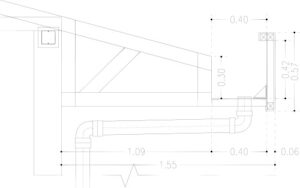Looking to find the best rain gutter size to install on your home or commercial property? No worries! Rain Guard OKC has got you covered.
When it comes to gutters, there is not a one-size-fits-all solution. To determine what is the best gutter size will depend on the total drainage area, pitch of your roof, and the average rainfall you receive in your area.

What Size Gutters Do You Need?
To know which gutters will be the best fit for your home, you will first need to calculate the total square footage of the gutter’s drainage area.
Drainage Area
To find the square footage of your drainage area, add the area of each slope of your roof to find out the total square footage of your roof’s surface.
Roof Pitch Factor
The next thing to consider while finding the best gutter size for your home is the steepness of your roof’s pitch. A steeper roof will collect more windblown rain, so it is important to factor this in. To measure your roof’s pitch, use a level and a tape measure: Hold one end of the level against the roof, level it, and then measure the distance between the roof and the underside of the level at its midpoint, which gives you a 12-inch run. A 7-inch gap is a 7/12 pitch. When you find the pitch of your roof, use the chart below to find the pitch factor.
Roof Pitch Factor Table
- 12/12 or higher: 1.3
- 9/12 to 11/12: 1.2
- 6/12 to 8/12: 1.1
- 4/12 to 5/12: 1.05
- Flat to 3/12: 1
Maximum Rainfall Intensity
The U.S Weather Bureau’s maximum rainfall intensity of your region is also needed to know if your gutters are large enough. A larger gutter system will be needed to support a higher amount of rainfall. This average can be found with a quick google search.
Sizing You Gutters
Once you acquire your calculated values, multiply your drainage area by the roof-pitch factor and rainfall intensity to find out your adjusted square footage. The size of your gutter will depend on which system you prefer.
K-Style Gutters
- Area less than 5,500 square feet: 5” Gutters
- Area over 5,500 square feet: 6” Gutters
Half Round
- Area less than 2,500 square feet: 5” Gutters
- Area over 2,500 square feet: 6” Gutters
One inch of rainfall on a roof that is 1,000 square feet equals more than 600 gallons of water! This makes it very important that you are picking the correct gutter size to effectively move water from your home.
Types of Gutters
The most common gutter styles are Aluminum and ½ Round Gutters. Aluminum Gutters are most commonly used in residential properties, while ½ Round are more common in older homes.
Aluminum Gutters
Aluminum Gutters are also known as K-Style or OG Gutters. They are very widely used and are standard for most homes. They are called “K-Style” because of the “K” shape that they make from a side profile; most Aluminum Gutters curve out on both the bottom and the top. The term “OG” comes from the architectural term “ogee,” which means double arc and refers to an “S” shape profile.
Aluminum Gutters provide a seamless finish which makes them less prone to leaks. They are also more durable and can hold a larger amount of water than rounded gutters. A couple downsides of Aluminum Gutters are that they are not the best option for older homes and are likely to collect debris.
½ Round Gutters
Half Round Gutters, unlike Aluminum Gutters, have a round shape that helps the water drain out as opposed to sitting flat in the gutter. This “U” shape aids in preventing corrosion. They complement older, historic homes; however, they can look great on modern homes that are less angular than the norm.
½ Round Gutters are a bit trickier to install than Aluminum Gutters, but they require less maintenance. There is minimal leakage and their round shape makes cleaning much easier. One downside to ½ Round Gutters is that you will need a larger gutter system to drain the same amount of water as a smaller Aluminum Gutter.
Different Gutter Sizes
The most common gutter sizes for residential properties are 5” or 6” gutters. 4”, 7”, and 8” gutters are much less common, but are used in special circumstances.
Gutter thickness is another factor to consider when sizing your gutters. A thicker gutter may provide more durability if you receive more intense rainfall or debris. Different gutter materials will vary in thickness. Aluminum systems usually range from .019 to .032 inches in thickness. Copper is rated in weight, where a heavier weight indicates greater thickness. Steel can be rated in thickness or gauge as well.
Why Do Rain Gutter Sizes Matter?
There is a lot that goes into choosing the best gutter size for your home. But knowing how to figure out the best fit for you will ensure that your home has long-lasting gutters and efficient rain protection.
Rain Guard Inc. has everything you need and everything you don’t know you need! Located in Oklahoma City and serving the OKC metro, we love to give our communities the best service around.
Remember all of those calculations for “pitch” and “drainage area?” If not, then call the gutter experts at Rain Guard OKC today to schedule your consultation and free estimate so you can get the job done right the first time.

